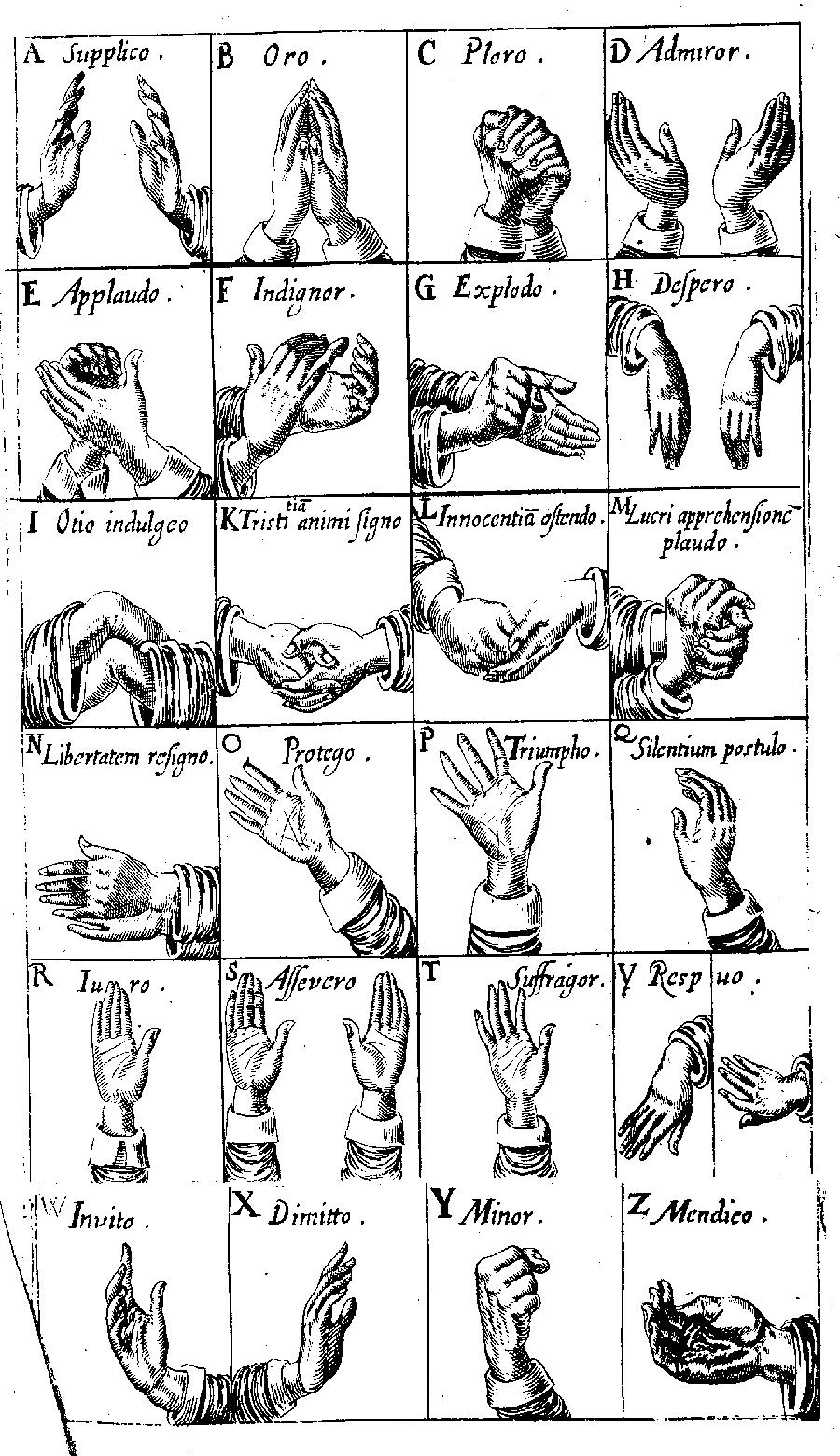|
Chironomia
Chironomia is the art of using gesticulations or hand gestures to good effect in traditional rhetoric or oratory. Effective use of the hands, with or without the use of the voice, is a practice of great antiquity, which was developed and systematized by the Greeks and the Romans. Various gestures had conventionalized meanings which were commonly understood, either within certain class or professional groups, or broadly among dramatic and oratorical audiences. Gilbert Austin was a well-known author on chironomia. The article about him contains a summary of theories in chironomia. See also * Gesticulation in Italian * Mudra References * John Bulwer, ''Chirologia ; Or the Natural Language of the Hand. Chironomia or the Art of Manual Rhetoric'' (1644). (Landmarks in rhetoric and public address). * Gilbert Austin Gilbert Austin (1753–1837) was an Irish educator, clergyman and author. Austin is best known for his 1806 book on chironomia, ''Chironomia, or a Treatise on Rh ... [...More Info...] [...Related Items...] OR: [Wikipedia] [Google] [Baidu] |
Gilbert Austin
Gilbert Austin (1753–1837) was an Irish educator, clergyman and author. Austin is best known for his 1806 book on chironomia, ''Chironomia, or a Treatise on Rhetorical Delivery''. Heavily influenced by classical writers, Austin stressed the importance of voice and gesture to a successful oration. Biographical information Gilbert Austin was born in 1753 in County Louth, Ireland. Educated at Trinity College, Dublin, Austin received his Bachelor of Arts degree in 1774 and his Master of Arts degree in 1780. After graduating, Austin established a private school in Dublin where he taught the sons of Ireland's elite, including Augustus Frederick FitzGerald, later Third Duke of Leinster (Robb and Thonssen 1966:xv-xvi). Austin inscribed his best-known work, ''Chironomia, or a Treatise on Rhetorical Delivery'', to another of his former pupils, Francis William Caulfeild, Earl of Charlemont. An active member of the Royal Irish Academy, Austin wrote several scientific papers describin ... [...More Info...] [...Related Items...] OR: [Wikipedia] [Google] [Baidu] |
Chironomia HandGestures
Chironomia is the art of using gesticulations or hand gestures to good effect in traditional rhetoric or oratory. Effective use of the hands, with or without the use of the voice, is a practice of great antiquity, which was developed and systematized by the Greeks and the Romans. Various gestures had conventionalized meanings which were commonly understood, either within certain class or professional groups, or broadly among dramatic and oratorical audiences. Gilbert Austin was a well-known author on chironomia. The article about him contains a summary of theories in chironomia. See also * Gesticulation in Italian * Mudra References * John Bulwer, ''Chirologia ; Or the Natural Language of the Hand. Chironomia or the Art of Manual Rhetoric'' (1644). (Landmarks in rhetoric and public address). * Gilbert Austin Gilbert Austin (1753–1837) was an Irish educator, clergyman and author. Austin is best known for his 1806 book on chironomia, ''Chironomia, or a Treatise o ... [...More Info...] [...Related Items...] OR: [Wikipedia] [Google] [Baidu] |
John Bulwer
John Bulwer (baptised 16 May 1606 – buried 16 October 1656 ) was an English physician and early Baconian natural philosopher who wrote five works exploring the Body and human communication, particularly by gesture. He was the first person in England to propose educating deaf people, the plans for an Academy he outlines in ''Philocophus'' and ''The Dumbe mans academie''. Life John Bulwer was born in London in 1606 and continued to work and live in the city until his death in October 1656 when he was buried in St Giles in the Fields, Westminster. He was the only surviving son of an apothecary named Thomas Bulwer and Marie Evans of St. Albans. On her death in 1638 John Bulwer inherited some property in St Albans from which he derived a small income. Although information about his education is unclear, there is evidence that he was probably educated in Oxford as an unmatriculated student in the 1620s. His known friends had nearly all been educated there and he supported Will ... [...More Info...] [...Related Items...] OR: [Wikipedia] [Google] [Baidu] |
Rhetoric
Rhetoric () is the art of persuasion, which along with grammar and logic (or dialectic), is one of the three ancient arts of discourse. Rhetoric aims to study the techniques writers or speakers utilize to inform, persuade, or motivate particular audiences in specific situations. Aristotle defines rhetoric as "the faculty of observing in any given case the available means of persuasion" and since mastery of the art was necessary for victory in a case at law, for passage of proposals in the assembly, or for fame as a speaker in civic ceremonies, he calls it "a combination of the science of logic and of the ethical branch of politics". Rhetoric typically provides heuristics for understanding, discovering, and developing arguments for particular situations, such as Aristotle's three persuasive audience appeals: logos, pathos, and ethos. The five canons of rhetoric or phases of developing a persuasive speech were first codified in classical Rome: invention, arrangement, style ... [...More Info...] [...Related Items...] OR: [Wikipedia] [Google] [Baidu] |
Mudra
A mudra (; sa, मुद्रा, , "seal", "mark", or "gesture"; ,) is a symbolic or ritual gesture or pose in Hinduism, Jainism and Buddhism. While some mudras involve the entire body, most are performed with the hands and fingers. As well as being spiritual gestures employed in the iconography and spiritual practice of Indian religions, mudras have meaning in many forms of Indian dance, and yoga. The range of mudras used in each field (and religion) differs, but with some overlap. In addition, many of the Buddhist mudras are used outside South Asia, and have developed different local forms elsewhere. In hatha yoga, mudras are used in conjunction with pranayama (yogic breathing exercises), generally while in a seated posture, to stimulate different parts of the body involved with breathing and to affect the flow of prana. It is also associated with bindu, bodhicitta, amrita, or consciousness in the body. Unlike older tantric mudras, hatha yogic mudras are generally inte ... [...More Info...] [...Related Items...] OR: [Wikipedia] [Google] [Baidu] |
Rhetoric
Rhetoric () is the art of persuasion, which along with grammar and logic (or dialectic), is one of the three ancient arts of discourse. Rhetoric aims to study the techniques writers or speakers utilize to inform, persuade, or motivate particular audiences in specific situations. Aristotle defines rhetoric as "the faculty of observing in any given case the available means of persuasion" and since mastery of the art was necessary for victory in a case at law, for passage of proposals in the assembly, or for fame as a speaker in civic ceremonies, he calls it "a combination of the science of logic and of the ethical branch of politics". Rhetoric typically provides heuristics for understanding, discovering, and developing arguments for particular situations, such as Aristotle's three persuasive audience appeals: logos, pathos, and ethos. The five canons of rhetoric or phases of developing a persuasive speech were first codified in classical Rome: invention, arrangement, style ... [...More Info...] [...Related Items...] OR: [Wikipedia] [Google] [Baidu] |
Jesus Chironomia
Jesus, likely from he, יֵשׁוּעַ, translit=Yēšūaʿ, label=Hebrew/Aramaic ( AD 30 or 33), also referred to as Jesus Christ or Jesus of Nazareth (among other names and titles), was a first-century Jewish preacher and religious leader; he is the central figure of Christianity, the world's largest religion. Most Christians believe he is the incarnation of God the Son and the awaited Messiah (the Christ) prophesied in the Hebrew Bible. Virtually all modern scholars of antiquity agree that Jesus existed historically. Research into the historical Jesus has yielded some uncertainty on the historical reliability of the Gospels and on how closely the Jesus portrayed in the New Testament reflects the historical Jesus, as the only detailed records of Jesus' life are contained in the Gospels. Jesus was a Galilean Jew who was circumcised, was baptized by John the Baptist, began his own ministry and was often referred to as "rabbi". Jesus debated with fellow Jews on how ... [...More Info...] [...Related Items...] OR: [Wikipedia] [Google] [Baidu] |


.jpg)
